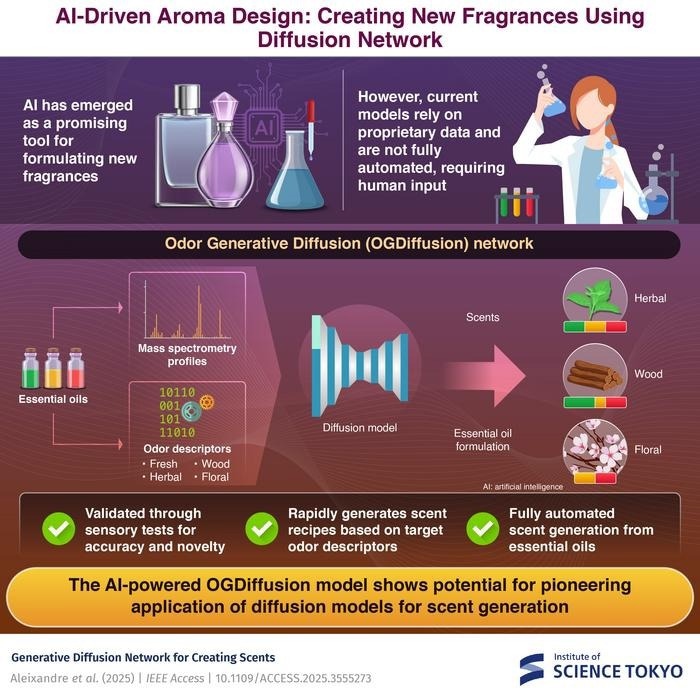Researchers at the Institute of Science Tokyo, under the direction of Professor Takamichi Nakamoto, have created an AI model named Odor Generative Diffusion that can automatically create new fragrances based on user-defined scent descriptors. This addresses the difficulties associated with fragrance design. Their research was published in the journal IEEE Access.
 The AI-powered OGDiffusion model shows potential for poineering application of diffusion models for scent generation. Image Credit: Institute of Science Tokyo
The AI-powered OGDiffusion model shows potential for poineering application of diffusion models for scent generation. Image Credit: Institute of Science Tokyo
The model creates essential oil blends for novel fragrances by utilizing mass spectrometry profiles of essential oils and associated odor descriptors. This innovation is revolutionary for the fragrance industry because it eliminates the need for trial-and-error and makes it possible to produce fragrances quickly and in large quantities.
Creating new fragrances is essential in sectors like perfumery, food, and home goods, where scent has a big impact on the overall experience of these products. However, creating a traditional fragrance can take a lot of time and frequently requires the knowledge and abilities of professional perfumers.
To get the desired scent, the process is usually difficult and time-consuming, involving multiple trial-and-error attempts.
Generative diffusion networks, a machine learning model that learns to produce new content by reversing a noise process informed by data already in existence, are used in this model. The team has modified this technology to produce new fragrances, and these models are already commonly used to produce text and images.
Nine odor descriptors, such as “citrus” or “woody,” are used to identify the 166 essential oils that make up the system's chemical profiles (mass spectrometry data). AI creates a matching chemical profile (mass spectrum) that corresponds with the descriptors that users specify for the desired scent characteristics.
Then, using a mathematical technique known as non-negative least squares, it determines the combination of essential oils required to replicate that aroma.
Our diffusion network uses patterns in mass spectrometry data of essential oils to generate new fragrance profiles in a fully automated, streamlined, and data-driven approach while maintaining high-quality data output. By eliminating human intervention and molecular synthesis from the process, we provide a fast, general, and efficient method for fragrance generation.
Takamichi Nakamoto, Professor, Institute of Science Tokyo
Even though models for AI-based fragrance generation have been developed, they still need expert input and rely on proprietary datasets. The new technique's main benefit is its ability to fully automate the creation of new scents. Furthermore, it is simple to replicate the final scent because the system creates fragrances using recipes for essential oils.
The team also performed human sensory tests to determine whether the AI-generated fragrances match the desired scent profiles. In a double-blind setup, 14 participants were asked to match AI-generated fragrances to suitable descriptors (like “citrusy” or “floral”).
The participants' consistent ability to recognize the right scent demonstrated the system's ability to generate fragrances that satisfied users' expectations. Participants in a different test were asked to distinguish between two scents: the original scent without that descriptor and one intended to express an additional specific odor descriptor.
The fact that they consistently chose the scent that matched the target descriptor suggests that the model produces distinct and recognizable scent profiles.
The first of its kind, Nakamoto's model portends a time when artificial intelligence will revolutionize fragrance design.
This approach represents a significant advancement in aroma design. By automating the generation of mass spectra corresponding to desired odor profiles, the OGDiffusion network offers a more efficient and scalable method for fragrance creation. Moreover, even a novice can create an intended scent to make scented digital contents.
Takamichi Nakamoto, Professor, Institute of Science Tokyo
In conclusion, this novel approach makes scent design quicker and more adaptable, and it may find use in a variety of sectors. The OGDiffusion model shows that computers can indeed have a creative nose by using AI to generate scents.
Journal Reference:
Aleixandre, M., et al. (2025) Generative Diffusion Network for Creating Scents. IEEE Access. doi.org/10.1109/access.2025.3555273.